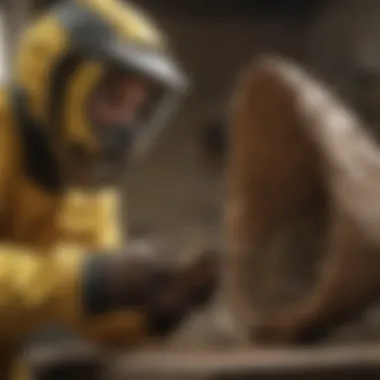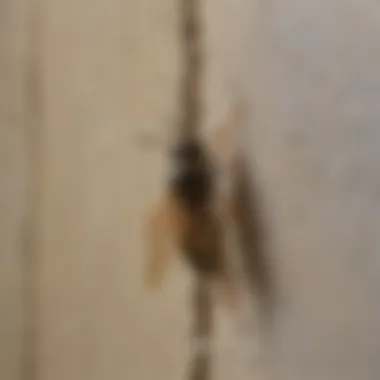Expert Tips for Safe and Effective Wasp Removal Inside Your Home


DIY Pest Control Techniques
For homeowners looking to take a hands-on approach to pest control, DIY techniques offer practical solutions for addressing pest issues. Homemade pest control remedies can be eco-friendly and cost-effective alternatives to commercial products. Using ingredients like baking soda, vinegar, or essential oils, you can create pest repellents and traps to safeguard your home.
Essential oils also play a role in natural pest control. Certain essential oils like eucalyptus or tea tree oil have insect-repellent properties that can help keep pests at bay. By diffusing essential oils or creating sprays, you can effectively deter insects without resorting to harsh chemicals.
Setting up pest traps and barriers is another DIY approach to pest control. Whether it's using sticky traps for crawling insects or creating physical barriers to prevent rodent access, these methods can help trap and exclude pests from your home.
When considering reputable pest control brands, look for products from trusted manufacturers that prioritize safety and efficacy. Ranging from insect repellents to rodent baits, reputable brands offer a range of solutions to address specific pest problems.
In addition to conventional solutions, there are various DIY pest control techniques that cater to specific pest issues at home. From gnat traps to fruit fly remedies, exploring DIY options can provide tailored solutions to tackle pest infestations effectively.
Identifying the Wasp
Recognizing the Wasp Species
Evaluating Physical Characteristics
Evaluating the physical characteristics of a wasp is vital in identifying the species accurately. Whether it's by examining the size, color patterns, or distinguishing features such as stripes or markings, these traits offer clues to the type of wasp present. Understanding these nuances not only aids in proper identification but also guides the selection of appropriate removal methods.
Researching Common Species in Your Area
Researching the common wasp species in your locality provides valuable insights into the behaviors and habits of these insects. By knowing which species are prevalent in your area, you can anticipate their nesting preferences and tendencies, aiding in the effective location and removal of their nests. This knowledge equips you with the foresight needed to tackle the wasp invasion efficiently.
Locating the Wasp's Nest


Locating the wasp's nest is the next step in the removal process. By pinpointing the exact location of the nest, you can strategize your removal approach and avoid unnecessary confrontations with the wasps. This section focuses on checking common nesting areas and listening for buzzing sounds to track down the source of the infestation.
Checking Common Nesting Areas
Conducting a thorough inspection of common nesting areas such as eaves, attics, and wall voids is essential in locating the wasp's nest. By exploring these typical spots where wasps tend to build their colonies, you increase the chances of discovering and eliminating the nest efficiently. This proactive approach sets the foundation for a successful removal operation.
Listening for Buzzing Sounds
Listening for buzzing sounds can lead you to the whereabouts of a hidden wasp nest. The faint hum of active wasps indicates their proximity and helps narrow down the search area. By relying on your auditory senses, you can track the buzzing sounds to their source and proceed with caution towards removing the nest, minimizing the risk of unexpected encounters.
Preparing for Removal
When it comes to dealing with a wasp in your house, proper preparation before removal is key to ensuring a safe and successful process. By taking the time to gather the necessary equipment and create an escape route, you can effectively manage the situation without putting yourself in harm's way or causing unnecessary stress. This section will cover the essential steps you need to take to prepare for the removal of a wasp in your house.
Gathering Necessary Equipment
Protective Clothing
Protective clothing plays a crucial role in safeguarding yourself during the wasp removal process. Equipping yourself with thick, long-sleeved clothing, gloves, a hat, and closed-toe shoes can significantly reduce the risk of stings. The key characteristic of protective clothing lies in its ability to provide a physical barrier between you and any potential threats, ensuring your safety throughout the removal procedure. The unique feature of protective clothing is its lightweight yet durable nature, allowing you to move freely while staying protected. Its advantage in this article is paramount, as it minimizes the chances of sustaining injuries from a provoked wasp, promoting a safe removal experience.
Removal Tools
Having the appropriate removal tools at hand is vital for handling a wasp infestation effectively. Tools like wasp spray, a long-reaching duster, and a flashlight enable you to access hard-to-reach areas and safely eliminate the insects. The key characteristic of removal tools is their precision and ease of use, making it simpler to target and eliminate wasps efficiently. Their unique feature lies in their specialized design for wasp removal tasks, ensuring optimal results with minimal effort. The advantage of using removal tools in this article is evident, as they facilitate a quick and strategic approach to removing wasps from your home.
Creating an Escape Route


Clearing Pathways
Clearing pathways throughout your home is a crucial step in preparing for wasp removal. By removing obstacles and debris from the area, you create a clear path for yourself and the wasp, minimizing the chances of accidental encounters. The key characteristic of clearing pathways is the enhancement of visibility and movement, allowing you to navigate through the space with ease and agility. Its unique feature lies in its ability to optimize the removal process by reducing potential barriers that may obstruct your path. The advantage of clearing pathways in this article is significant as it promotes a safe and efficient environment for both you and the wasp during the removal procedure.
Securing Doors and Windows
Securing doors and windows is essential in preventing the escape of the wasp during removal and ensuring your safety. By sealing gaps, using mesh screens, and closing off entry points, you create a barrier that restricts the wasp's movements and limits its potential exit routes. The key characteristic of securing doors and windows is its ability to provide airtight protection, preventing any unwelcome intrusions while maintaining adequate ventilation. Its unique feature lies in its versatility, offering multiple ways to secure various entry points effectively. The advantage of securing doors and windows in this article is paramount, as it guarantees a controlled environment for the safe removal of the wasp from your home.
Executing Safe Removal
Executing safe removal of a wasp in your house is a critical aspect covered in this article. When it comes to dealing with wasps, safety should always be the top priority. By executing safe removal methods, you not only protect yourself from potential stings but also ensure a humane approach towards handling these insects.
Keeping Calm and Collected
Avoiding Sudden Movements:
Avoiding sudden movements is a crucial element in safely removing a wasp. Sudden movements can startle the insect, leading to aggressive behavior and increasing the risk of being stung. By remaining calm and avoiding quick actions, you create a more controlled environment for removing the wasp. This method is popular because it minimizes the chances of provoking the wasp, promoting a safer removal process. The unique feature of avoiding sudden movements lies in its ability to maintain a peaceful demeanor, reducing the likelihood of a defensive wasp response. While it requires patience, the advantage of this approach is a lower risk of confrontation and stings during the removal process.
Maintaining a Steady Pace:
Maintaining a steady pace is key to executing safe removal of a wasp. Moving too quickly can agitate the insect and lead to a heightened state of alert, increasing the risk of stings. By staying composed and deliberate in your actions, you demonstrate a sense of control that can help guide the removal process smoothly. This method is beneficial because it allows you to maintain a structured approach, minimizing the potential for erratic behavior from the wasp. The unique feature of maintaining a steady pace is its ability to convey a sense of calm authority, reassuring both yourself and the wasp. While it requires focus, the advantage lies in reducing the likelihood of escalating the situation and promoting a peaceful removal process.
Using Non-Lethal Methods
Guiding the Wasp Out:


Guiding the wasp out of your house is a non-lethal method that contributes to the overall safety of the removal process. By gently encouraging the wasp to leave through an open window or door, you avoid the need for aggressive tactics that could harm the insect. This method is popular for its humane approach, allowing the wasp to exit on its own accord. The unique feature of guiding the wasp out is its emphasis on natural behavior, leveraging the insect's instinct to seek an escape route. The advantage of this method is the avoidance of direct confrontation, reducing the stress on both you and the wasp during the removal.
Sealing Entry Points:
Sealing entry points in your home is a preventive measure that complements the safe removal of a wasp. By blocking potential entryways such as cracks or gaps, you can deter future intrusions by these pests. This method is beneficial because it proactively addresses possible entry points, reducing the likelihood of recurrent wasp invasions. The unique feature of sealing entry points is its focus on long-term protection, creating a barrier that inhibits wasps from entering your living space. While it requires initial effort, the advantage lies in maintaining a wasp-free environment and preventing future encounters with these insects.
Post-Removal Measures
In the realm of wasp removal, the phase post-removal holds a significant role in ensuring a sustainable solution to the intrusion of these stinging insects within your home. By conducting meticulous inspections and implementing preventive measures, one can effectively avoid future encounters with wasps. This section elucidates the crucial steps to take after the physical removal of the wasp within your premises. Post-removal measures not only enhance the safety and security of your household but also mitigate the chances of a wasp resurgence.
Inspecting for Recurring Wasps
Inspecting for recurring wasps constitutes a pivotal aspect of post-removal measures. After an initial removal, it is imperative to conduct thorough checks to ascertain the absence of stragglers that may have evaded earlier detection. Monitoring the activity around potential nesting sites ensures proactive eradication of any imminent wasp presence, thereby safeguarding your living environment from further infestations.
Checking for Stragglers
Checking for stragglers involves meticulous scrutiny of indoor and outdoor spaces where wasps typically linger. This meticulous process encompasses inspecting hidden corners, crevices, and secluded areas where these resilient insects may seek refuge. A keen eye is essential to identify any solitary wasps that might have eluded prior extermination attempts. This method guarantees a comprehensive eradication of wasp remnants, minimizing the chances of unexpected confrontations.
Monitoring Activity
Monitoring wasp activity post-removal is a proactive measure that aids in detecting any resurgence in their population. By observing the behavior of these insects in and around your residence, you can gauge the effectiveness of preventive measures and identify early signs of a potential infestation. Tracking the movement patterns and nesting tendencies of wasps enables timely intervention, safeguarding your home from recurring incursions.
Preventative Measures
Mitigating the risk of future wasp intrusions necessitates the implementation of preventative measures to fortify your household against these unwelcome guests. Sealing entry points serves as a first line of defense against wasp infiltration, while implementing wasp deterrents reinforces this protective barrier, deterring these insects from revisiting your premises.
Sealing Entry Points
Sealing entry points entails identifying and closing off potential gaps, cracks, and openings that serve as entryways for wasps. By thoroughly inspecting your home's exterior and interior for vulnerable areas, you can prevent wasps from accessing conducive nesting sites. This preventive strategy not only impedes their entry but also enhances the structural integrity of your property, ensuring long-term protection against insect invasions.
Implementing Wasp Deterrents
Implementing wasp deterrents involves deploying natural or commercial repellents that discourage wasp activity in and around your home. These deterrents leverage scents or substances that repel wasps, deterring them from establishing nests in close proximity. By strategically situating deterrents based on wasps' foraging and nesting behavior, you can create a hostile environment that dissuades their presence, offering a non-intrusive solution to wasp control.



